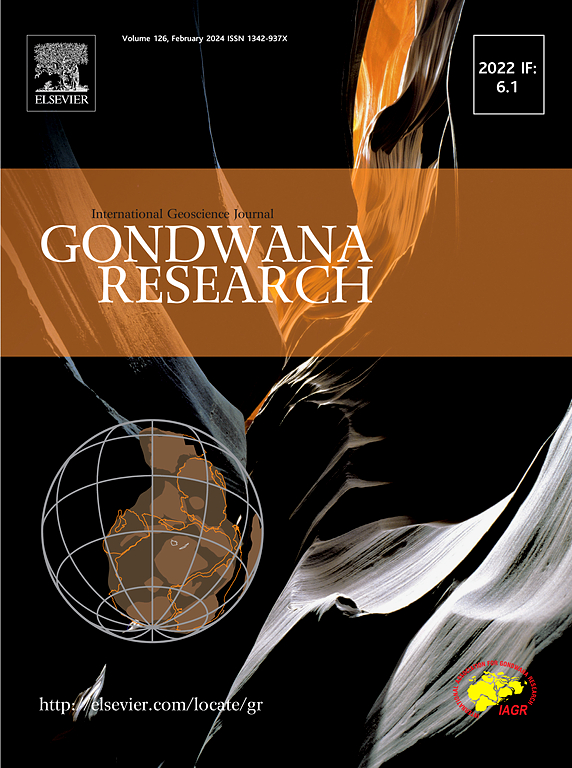IODP U1477遗址晚更新世沉积物物源分析揭示了赞比西河流域的气候和流域动态
IF 7.2
1区 地球科学
Q1 GEOSCIENCES, MULTIDISCIPLINARY
引用次数: 0
摘要
沉积在边缘海洋环境中的沉积物质的来源为了解邻近河流集水区的演化条件提供了重要的见解,从而揭示了盆地动力学和气候变化。本文利用稀土元素(REE)组成和Sr-Nd-Hf同位素特征研究了位于赞比西河河口外海的国际海洋发现计划(IODP)遗址U1477过去15万年(ka)沉积物的物源。这些地球化学和同位素指标表明,近150 ka以来,整个赞比西河流域向赞比西河河口附近海域贡献了沉积物。明显的非放射性成因的εNd和εHf特征与高放射性成因的87Sr/86Sr值相结合,反映了ZRB中下游的沉积物输入。相反,较高的放射性成因的εNd和εHf特征以及非放射性成因的87Sr/86Sr值表明沉积物来自上游。U1477遗址的地球化学和同位素数据表明,晚更新世沉积物物源发生了重大变化。通过将我们的发现与其他来自海洋沉积物和古湖泊岩心的古气候记录相结合,我们推断赞比西河上游沉积物来源对近海沉积物的贡献从大约40 ka开始增加,反映了此时赞比西河上游和中部沉积物供应的重建。这些变化可能与横跨ZRB的区域降雨模式的变化有关,以及由于乔贝断层在乔贝-赞比西河汇合处附近的构造隆起引起的活跃基岩侵蚀引起的沉积物负荷变化而导致的排水分区的改变。该研究为研究赞比西河流域晚更新世的演化提供了新的视角,对准确重建区域气候和环境变化具有重要意义。本文章由计算机程序翻译,如有差异,请以英文原文为准。

Provenance analysis of late Pleistocene sediment from IODP site U1477 reveals climate and river basin dynamics in the Zambezi river catchment
The provenance of sedimentary material deposited in marginal marine environments offers significant insights into the evolving conditions within adjacent river catchments, thereby revealing the basin dynamics and climate variations. In this study, we used rare earth element (REE) compositions and Sr-Nd-Hf isotope signatures to investigate the provenance of sediments at International Ocean Discovery Program (IODP) Site U1477, located offshore of the Zambezi River mouth, over the past 150 thousand years (ka). These geochemical and isotope proxies indicate that the entire Zambezi River Basin (ZRB) has contributed sediments to the offshore region near the Zambezi River mouth during the last approximately 150 ka. Distinctly unradiogenic εNd and εHf signatures coupled with highly radiogenic 87Sr/86Sr values are indicative of sediment input from the middle and lower reaches of the ZRB. Conversely, more radiogenic εNd and εHf signatures along with unradiogenic 87Sr/86Sr values suggest sediment contributions from the upper reaches. The geochemical and isotope data from Site U1477 thus reveal that substantial changes in the sediment provenance occurred during the Late Pleistocene. By integrating our findings with other paleoclimate records from marine sediments and paleolake cores, we infer that the increased contribution of the upper Zambezi sediment sources to the offshore deposits from approximately 40 ka onwards reflects the reestablishment of the sediment supply from both the upper and middle Zambezi at this time. These changes were likely associated with shifts in the regional rainfall patterns across the ZRB, as well as modifications of the drainage divides due to varying sediment loads resulting from active bedrock erosion following the tectonic uplift on the Chobe fault near the Chobe–Zambezi confluence. This study offers novel insights into the Late Pleistocene evolution of the Zambezi drainage system and is essential for accurately reconstructing regional climate and environmental changes.
求助全文
通过发布文献求助,成功后即可免费获取论文全文。
去求助
来源期刊

Gondwana Research
地学-地球科学综合
CiteScore
12.90
自引率
6.60%
发文量
298
审稿时长
65 days
期刊介绍:
Gondwana Research (GR) is an International Journal aimed to promote high quality research publications on all topics related to solid Earth, particularly with reference to the origin and evolution of continents, continental assemblies and their resources. GR is an "all earth science" journal with no restrictions on geological time, terrane or theme and covers a wide spectrum of topics in geosciences such as geology, geomorphology, palaeontology, structure, petrology, geochemistry, stable isotopes, geochronology, economic geology, exploration geology, engineering geology, geophysics, and environmental geology among other themes, and provides an appropriate forum to integrate studies from different disciplines and different terrains. In addition to regular articles and thematic issues, the journal invites high profile state-of-the-art reviews on thrust area topics for its column, ''GR FOCUS''. Focus articles include short biographies and photographs of the authors. Short articles (within ten printed pages) for rapid publication reporting important discoveries or innovative models of global interest will be considered under the category ''GR LETTERS''.
 求助内容:
求助内容: 应助结果提醒方式:
应助结果提醒方式:


